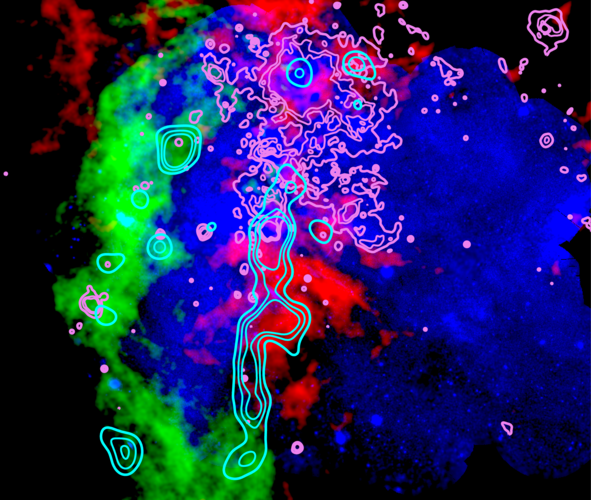Our galaxy is surrounded by numerous ‘satellite’ galaxies, the largest being the Large Magellanic Cloud (LMC). The LMC is a complex mix of stars, gas and molecular clouds, and hosts many fascinating celestial objects and features – including the huge and luminous region of 30 Doradus, otherwise known as the Tarantula Nebula. This nebula is the most vigorous known star-forming region in the local Universe, and bright enough to be clearly visible from Earth’s southern hemisphere with the naked eye.
The LMC also houses a feature named the ‘X-ray spur’. Formed of gas so hot that its constituent atoms have split into charged particles (a form of matter known as plasma), the X-ray spur is a large, extended, triangular structure that lies to the south of the Tarantula Nebula and stretches out for almost half the diameter of the LMC itself. The spur emits far more energetic X-rays than we would typically expect from the plasma in a galaxy, and so it has intrigued scientists studying the local cosmos.
Researchers have now used ESA’s XMM-Newton X-ray observatory to explore the emission streaming from the X-ray spur at multiple wavelengths. They find that the gas making up the spur is far hotter than gas in other parts of the LMC. It is similar to the temperatures found in the region around the Tarantula Nebula, which is heated by the numerous young, massive stars forming within it. However, there are no signs of star formation – either past or present – in the spur.
So, what is causing these extreme temperatures? The scientists think that the spur is heated by two giant clouds of cool hydrogen gas that are in the process of colliding – and heating up their surroundings in the process. These clouds are shown in this image of the south-eastern part of the LMC in green and red, with their mapping based on combined data from the Australia Telescope Compact Array and Parkes 21 cm multibeam survey (both CSIRO, Australia). XMM-Newton’s X-ray data – from the spacecraft’s European Photon Imaging Camera, or EPIC – is shown in blue, and traces the X-ray spur as it lies directly between these two colliding clouds. The researchers predict that the spur will eventually evolve into a stellar nursery like its neighbour, the Tarantula Nebula (see location of the nebula in this image).
Additionally, two sets of contours are overlaid on the image: the cyan contours show carbon monoxide emission from molecular clouds, which are high-density regions that harbour new star-forming regions (based on data from the 4m NANTEN telescope, located at the Las Campanas Observatory in Chile and operated by Nagoya University, Japan). The magenta contours, meanwhile, track ‘H-alpha’ emission — patches of hydrogen where incoming radiation from massive stars has caused the gas to lose electrons (based on H-alpha data from the Magellanic Clouds Emission Line Survey, obtained by the Cerro Tololo Inter-American Observatory in Chile).
The image shows a patch of sky centred at a right ascension (RA) of roughly 5h37m00s and declination (Dec) of approximately -69°30’00” to -70°00’00”. This celestial coordinate system is used to identify locations in space, with Dec and RA being analogous to terrestrial latitude and longitude, respectively.



 Image:
When clouds collide
Image:
When clouds collide